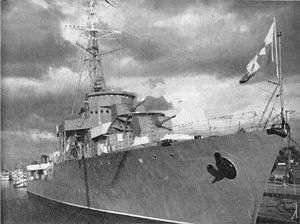ORP Burza
 ORP Burza as a museum ship. | |
| History | |
|---|---|
| Name: | ORP Burza |
| Namesake: | thunderstorm |
| Ordered: | 2 April 1926 |
| Builder: | Chantiers Navals Francais, Blainville[1] |
| Laid down: | 1 November 1927 |
| Launched: | 16 April 1929[2] |
| Commissioned: | 10 July 1932 |
| Decommissioned: | 28 June 1960 |
| Fate: | Turned into museum ship; later scrapped |
| General characteristics | |
| Class and type: | Wicher-class destroyer |
| Displacement: |
|
| Length: | 106.9 m (350 ft 9 in) |
| Beam: | 10.5 m (34 ft 5 in) |
| Draft: | 3.5 m (11 ft 6 in) |
| Installed power: | 35,000 shp (26,000 kW)[1] |
| Propulsion: | geared turbines |
| Speed: | 33.8 knots (62.6 km/h; 38.9 mph) |
| Complement: | 162 |
| Armament: |
|
ORP Burza was a Wicher-class destroyer of the Polish Navy which saw action in World War II.
History
ORP Burza (Polish: squall or storm) was ordered on 2 April 1926 from the French shipyard Chantiers Naval Francais together with her sister ship Wicher. She entered service in 1932 (roughly 4 years after the initial deadline), and her first commander became kmdr Bolesław Sokołowski.
On 30 August 1939 the Polish destroyers ORP Burza, Błyskawica and Grom were ordered to execute the Peking Plan, and the warships headed for Great Britain. On 1 September 1939, Polish destroyers met the British destroyers HMS Wanderer and Wallace. The British ships led the Polish ships to Leith, and at night the Polish destroyers arrived at Rosyth.
Burza assisted British forces off Norway in April 1940, and in the English Channel in May, 1940.[3] Midshipman Konstanty Okolow-Zubkowski served on the Burza at this time. He reported that the ship made one run to Dunkirk and rescued nearly 200 soldiers from the water. Soldiers climbed aboard using netting, boathooks and the like. During the rescue of the soldiers the Burza took a direct hit from a bomb in the bows which caused substantial damage below decks and blew out the bows. Fortunately none of the rescued soldiers were in that part of the ship. The Burza had to return to Dover in reverse (stern first) as the ship's commander dare not risk pressure on the bows with risk of the bows breaking away. Later the ship's crew were touched to receive letters of thank you from the soldiers that they had rescued. After substantial repairs over several months at Portsmouth, the Burza escorted convoy HX-217 as part of Escort Group B-6.[4] While attached to Escort Group B-3, Burza escorted convoys ONS-167, HX-228, and SL-147/MKS-38.[5] Burza was detached from ONS-167 to defend Convoy ON-166.[6][7] While attached to Support Group 8, Burza escorted convoy SC-145 and the October 1943 convoy to establish British air bases in the Azores.[7] In 1944, Burza became a training ship, and in 1945 she became a submarine tender for Polish submarines. The Polish crew left the ship in 1946, when Burza was transferred to the Royal Navy.
In 1951, the ship was returned to the Polish Navy and towed to Gdynia in July. Burza was overhauled and entered service in 1955. In 1960, she became a museum ship. After Błyskawica replaced her in that role, she was scrapped in 1977.
Commanders
- kmdr Bolesław Sokołowski (1932–33)
- kmdr ppor. M. Majewski (1933–37)
- kmdr ppor. Włodzimierz Kodrębski (1937)
- kmdr ppor. Stanisław Nahorski (1937–40)
- kmdr ppor. Antoni Doroszkowski (1940)
- kpt. mar Jan Tchórznicki (temporary)
- kmdr ppor. Zbigniew Wojciechowski (1941–42)
- kpt. mar. Franciszek Pitułko (1942–43)
- por mar. Stanisław Kinka (temporary)
- por. mar. Przemysław Wesołowski (temporary)
- kmdr ppor. Wacław Trzebiński (1944–46)
Armament
1932-1940:
- Four 130 mm Schneider-Creusot guns (4x1)
- Two 40 mm Vickers - Armstrong AA cannons (2x1)
- Four 13,2 mm Hotchkiss AA machine guns (2x2), from 1935
- Six torpedo tubes 550/533 mm (2x3)
- Two depth charge launchers
- One depth charge thrower Thornycroft
- 30 mines
1940-1942:
- Four 130 mm Schneider-Creusot guns (4x1)
- One 76 mm Mk Vna gun
- Two 40 mm Vickers - Armstrong AA cannons (2x1)
- Four 13,2 mm Hotchkiss AA machine guns (2x2)
- Eight 12,7 Vickers AA machine guns (2x4)
- Three torpedo tubes 550/533 mm (1x3)
- Two depth charge launchers
- Two depth charge throwers Thornycroft
1942-1946:
- Two 130 mm Schneider-Creusot guns (2x1)
- One 76 mm Mk Vna gun
- Four 40 mm AA Mk VIII cannons (1x4)
- Four 20 mm AA Oerlikon cannons
- Three torpedo tubes 550/533 mm (1x3)
- One hedgehog
- Two depth charge launchers
- Four depth charge throwers Thornycroft
From 1955:
- Four 100 mm guns (4x1)
- Eight 37 mm AA cannons (4x2)
- One depth charge launcher
- Four depth charge throwers
See also
References
- Kafka, Roger & Pepperburg, Roy L. (1946). Warships of the World. Cornell Maritime Press.
- Morison, Samuel Eliot (1975). History of United States Naval Operations in World War II, Volume I The Battle of the Atlantic 1939-1943. Little, Brown and Company.
- Preston, Anthony (1989). Jane's Fighting Ships of World War II. Random House. ISBN 0-517-67963-9.
- Rohwer, J. & Hummelchen, G. (1992). Chronology of the War at Sea 1939-1945. Naval Institute Press. ISBN 1-55750-105-X.